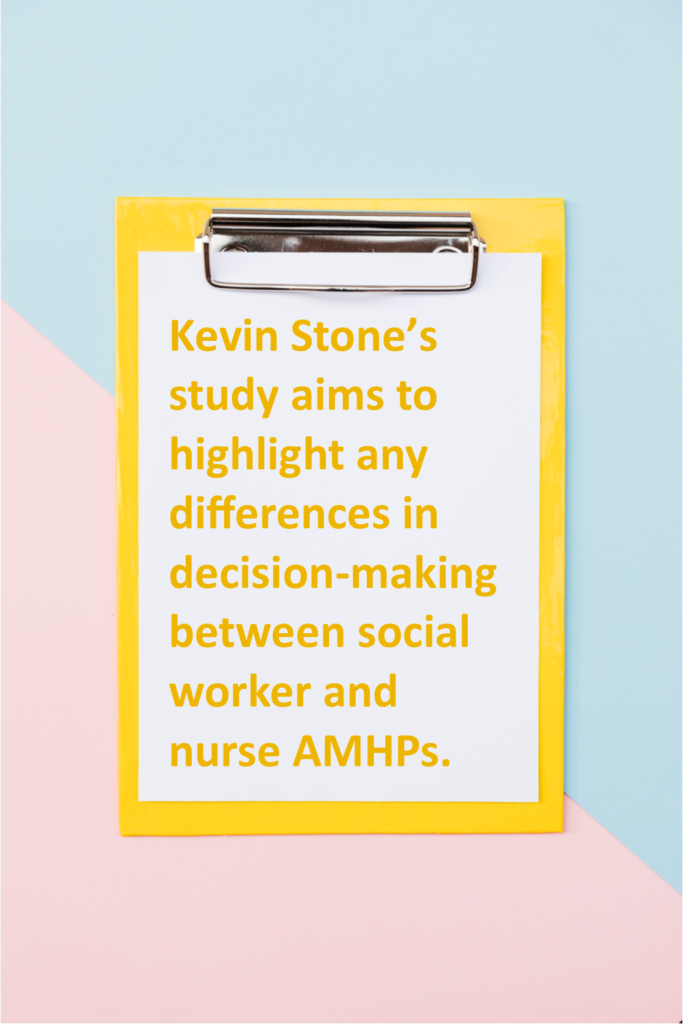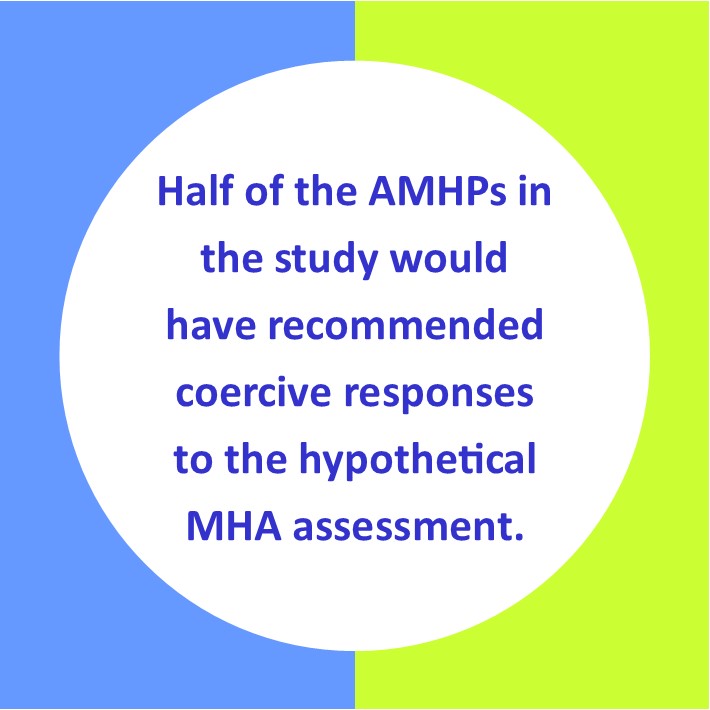
Approved Mental Health Professionals (AMHPs) were empowered under the Mental Health Act 2007 (replacing Approved Social Workers) to make decisions to detain people with mental health needs under the Mental Health Act 1983 (MHA). The AMHP has to make this decision on the basis of the least restrictive option, which includes the requirement to consider community alternatives and to consider whether there is a need to intervene at all. In addition to social workers (who, as Approved Social Workers, previously had the same responsibility), learning disability and mental health nurses, occupational therapists (OTs) and psychologists are now able to train and practice as AMHPs. However, currently only 5% of AMHPs are not social workers, the vast majority of whom are nurses (Skills for Care, 2018). The paper I review in this blog by Kevin Stone aims to highlight any differences between social worker and nurse AMHPs’ decision-making and reasoning behind decisions. Stone intended to include all professional groupings but only social workers and nurses took part in the study. Deciding to deprive a person of their liberty is an enormous responsibility (Morris, 2014). Given the seriousness of this work, it is important to explore whether the new professionals now working as AMHPs are making decisions in systematically different or broadly similar ways to social workers.

Kevin Stone’s study aims to highlight any differences in decision-making between social worker and nurse AMHPs.
Methods
Ten social worker and ten nurse AMHPs took part in the study. While no information is given about location, the gender, age and experience of each participant is given. Unsurprisingly, most of the social workers had worked as social workers for longer than the nurse AMHPs taking part in the study had been nurses. Participants were interviewed for about 90 minutes: interviews incorporated a vignette of a MHA assessment, which:
… articulated the case history and current presentation of a black Afro-Caribbean male referred to as Mr Anderson, who lived alone with a history of mental health and social economic difficulties. There had been a history of mixed engagement with social care and health services… (Stone 2019, p6)
After reading the vignette, participants were shown a video based on the vignette. They were asked ‘what would you do next?’ and then asked to explain their answers.
Findings
There were varied responses to the vignette, as shown in Table 1. Half (10) of the AMHPs, six social workers and four nurses, would have recommended a ‘coercive’ response, such as compulsory detention in hospital (Table 1).
| Table 1. What participants decided to do following the vignette (Stone 2019, p84) | ||
| Nurse AMHPs | Social Work AMHPs | |
| Section 4 MHA (emergency detention for 72 h) | 0 | 0 |
| Section 2 MHA (to detain for up to 28 days) | 2 | 2 |
| Section 3 MHA (to detain up to 6 months) | 0 | 0 |
| Seek a Section 135(1) warrant (Return to the house with assistance of the police to gain entry and hold the occupant) | 2 | 4 |
| Community Treatment (NOT Community Treatment Order) (supported in their own home by a specialist team) | 3 | 2 |
| Try to re-engage (Mental health team to visit, or telephone again without using the MHA) | 2 | 1 |
| Postpone making a decision (Participant could not make a decision) | 1 | 1 |
The research also presented the AMHPs’ reasoning for their decisions. Of the four participants recommending immediate detention, one focused on the risks presented such as psychosis, threats and carrying a weapon. Another was considering a possible future Community Treatment Order, which would have required a Section 3 order (detaining the person for up to six months), but their decision was to limit the detention to an initial maximum of 28 days, in the hope that Mr Anderson would engage in voluntary treatment.
The six AMHPs considering a Section 135 referral and a return with warrants felt that a full assessment had not been possible and that there was enough evidence of risk to justify the need for a further assessment. However, these AMHPs hoped that efforts to engage Mr Anderson in voluntary treatment might make a further assessment unnecessary. Stone notes that all of these participants who were recommending coercive responses were trying to stick to the ‘least restrictive option’.
A major theme underpinning AMHPs’ decisions not to recommend detention was also to seek to engage Mr Anderson in voluntary treatment, which would also allow time for further reflection and an indication of a desire to work with him collaboratively. Some wanted to delay decisions until these kinds of avenues could be explored, rather than categorically rule out possible detention. The kinds of community included crisis teams, home treatment, or offering support themselves.

Half of the AMHPs in the study would have recommended coercive responses to the vignette of a MHA assessment, such as a compulsory detention in hospital.
Conclusions
Stone concludes that there was at least as much variation in decision-making between AMHPs from the same professional background as there was between AMHPs with different professional backgrounds. Similarly, there was no sign of a consistently different interpretation of the problems Mr Anderson presented with between AMHPs of different professional background.

Stone concludes that there was at least as much variation in decision-making between AMHPs from the same professional background as there was between AMHPs with different professional backgrounds.
Strengths and limitations
Stone notes the limits of the research because of the small sample, in relation to generalisation of the findings. Stone acknowledged that using a pre-existing video limited the scope of the vignette, as certain aspects had been set. I note that there was no examination of the impact of using video instead of sticking with written material. Stone explores the potential impact of his role as researcher, given his experiences as an AMHP. While this helped in being able to understand the nature of the AMHP role, he was concerned about his over-identification with participants and not being able to ask ‘naïve questions’. The chances of over-identification were reduced by not recruiting AMHPs from his area, but the impact on the analysis is not explored. More suggestions for further, quantitative, research, which could provide more generalisable evidence about the decision making of AMHPs from different professions, could have been made. Furthermore, as the vignette focused on a black male patient, further research involving vignettes involving women and men from different ethnic backgrounds might have been useful as comparators.

Stone explores the potential impact of his role as researcher, given his experiences as an AMHP and was concerned about not being able to ask ‘naïve questions’.
Implications for practice
Stone argues that decision-making and reasoning were “within [participants’] socially constructed ideological view of the world (Lock and Strong 2010)”(2019, p10). Furthermore, Stone’s interpretation is that individual agency rather than professional socialisation underpins AMHPs’ decision-making, which will be influenced by individual histories and contexts and personal risk thresholds. This is likely to affect user outcomes, despite the influence of the common training received by AMHPs. Such findings fit with those of Vicary (2016), also based on a PhD thesis, which explored social workers and nurse AMHPs approaches to decision-making. Vicary found that nurses were able to perform the role successfully, and stressed the importance of context and external limitations (such as the shortage of community alternatives to detention), rather than professional socialisation as influences on decision-making. The article presents good qualitative evidence about the nature of AMHP decision-making, which could be used to develop initial training and on going professional development for AMHPs.

Stone’s interpretation is that individual agency rather than professional socialisation underpins AMHPs’ decision-making.
Conflicts of interest
None.
Links
Primary
Stone, K. (2019). Approved mental health professionals and detention: An exploration of professional differences and similarities. Practice, 31(2), 83-96.
Other
Mental Health Act 2007 (c12) London: Stationery Office. Available from: https://www.legislation.gov.uk/ukpga/2007/12/contents (Accessed 01/08/2019)
Mental Health Act 1983 (c20) London: Stationery Office. Available from: https://www.legislation.gov.uk/ukpga/1983/20/contents (Accessed, 01/08/2019)
Lock, A., and T. Strong. 2010. Social Constructionism: Sources and Stirrings in Theory and Practice. Cambridge: Cambridge University Press.
Morriss, L. 2014. Accomplishing social work identity in interprofessional mental health teams following the implementation of the Mental Health Act, 2007. Salford, Doctor of Philosophy, University of Salford. Available from http://usir.salford.ac.uk/30876/ (Accessed 01/08/2019)
Vicary, S. 2016. An Interpretative Phenomenological Analysis of the impact of professional background on role fulfilment: a study of approved mental health practice. Manchester, Doctor of Philosophy PhD, University of Manchester. Available from: http://oro.open.ac.uk/51197/ (Accessed 01/08/2019)
Skills for Care (2018). The Approved Mental Health Professional Workforce, Leeds, Skills for Care. Retrieved from: https://www.skillsforcare.org.uk/NMDS-SC-intelligence/Workforce-intelligence/documents/AMHPs-Briefing.pdf (Accessed 01/08/2019)
Images
Feature: Image by jcomp via Freepik.com
Image 1: Adapted from image from Freepik.com
Image 2: Original
Image 3: Image by Janoon028 via Freepik.com
Image 4: Image by dooder via Freepik.com
Image 5: Rawpixel.com on Freepik.com
